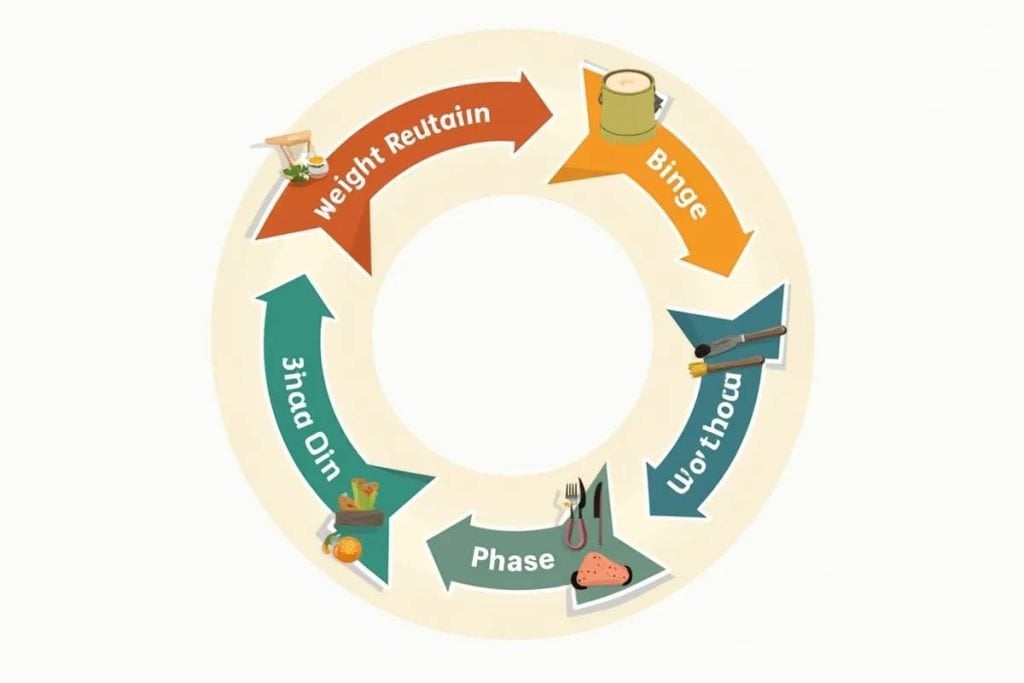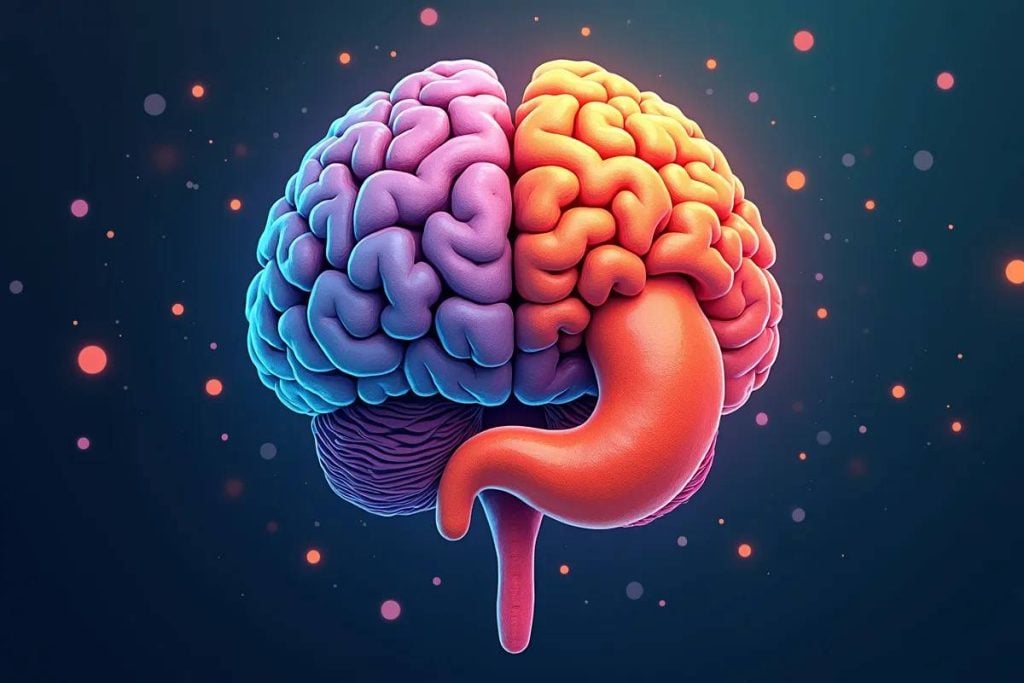Ever feel like you’re stuck on a never-ending diet treadmill, losing and gaining weight without seeing lasting results? You’re not alone.
We dive deep into the common pitfalls of fad diets and offer a refreshing, sustainable approach to eating that honors both your body and your lifestyle. Say goodbye to restrictive eating and hello to a balanced, joyful relationship with food!
Understanding the Diet Cycle

The Vicious Cycle of Dieting
Folks often get stuck in a never-ending loop of dieting, trying to shed pounds fast. You start strong—motivated and dropping weight like nobody’s business—but, spoiler alert, it ain’t built to last. The strictness of diets sneak up on you, making you feel deprived, and before you know it, you’re back to those comforting snacks and gaining it all back. Talk about a buzzkill!
| Stage | Description |
|---|---|
| Initial Dieting | Kick off a new diet with sky-high motivation and early weight loss. |
| Deprivation Phase | Start feeling restricted ’cause of the limited food options. |
| Binge/Cheat Phase | Crave intensely, leading to munching marathons or those infamous “cheat days.” |
| Weight Regain | Slide back into old eating habits, and, yep, that weight comes back. |
| Cycle Repeats | Feel guilty, jump on another diet, and here we go again. |
Going round and round like this isn’t just tiring; it messes with both the body and mind. Cracking the code to stop this merry-go-round can set you on a path to lasting success. Our intuitive eating guide shakes things up with a fresh way to vibe with your food.
Common Pitfalls of Fad Diets
Those trendy diets might sound like magic with their promises of slimming down fast, but they’re often selling you a dream. Usually, they cut out whole food groups or slash calorie counts drastically. Sure, you might drop some weight for a minute, but sticking to them is as tough as nails, and they can throw your nutrient game way off.
Common Pitfalls:
- Nutrient Shortages: Quick-fix diets skimp on the good stuff, messing with your health. For a more well-rounded route, check our balanced nutrition principles.
- Tortoise Metabolism: Slash calories like crazy, and your metabolism might just plan a strike, making it trickier to keep pounds off.
- Emotional Whirlwind: The stern rules of fad diets can twist you into emotional munching and the blues when you veer off course. Get schooled on emotional vs physical hunger.
- Temporary Slimdown: These diets aren’t exactly marathon runners—the weight comes back, repeating the cycle.
| Fad Diet | Common Traits | Potential Setback | |
|---|---|---|---|
| Keto | Heavy on fats, light on carbs | Nutri-deficient, not for the long haul | |
| Detox/Cleanses | All about juices or select foods | Skimpy on protein and fiber, Nutri-deficient | |
| Low-Fat | Bye-bye fats from your plate | Could miss crucial fatty acids | |
| Intermittent Fasting | Eating only during certain hours or days | Might lead to feast fest in allowed periods |
Understanding these stumbling blocks and aiming for a nutritious equilibrium can help dodge fad diet hiccups. If you’re curious to weave mindfulness into your meals, peek at mindful eating techniques to get the hang of tuning into your hunger signals and cozying up to a more sustainable meal mindset.
Mindful Eating Approach

Breaking free from roller-coaster dieting and stepping into a livelier, healthier lifestyle starts with eating mindfully. It’s all about trusting your gut (literally!) and paying attention to what’s going on inside your body.
Embracing a Sustainable Mindset
Think long-term happiness, not quick-fix chaos. A sustainable mindset is like planting a garden—patience and care will make it thrive. This is about ditching the all-or-nothing diet thinking and striking a lovely balance with food. Remember, food is your friend, not a fright.
- Set Doable Goals: Go for changes that ain’t gonna scare the pants off ya.
- Practice Patience: No magic wands here. Real change is a slow dance, not a sprint.
- Focus on Enjoyment: Savor every bite—let your taste buds party.
- Stay Informed: Check out balanced nutrition tips to keep things in check.
By blending these practices into your daily grind, you’ll craft a way of eating that fits your vibe, sidestepping those nasty diet pitfalls. Buh-bye food guilt, hello fabulous you! For more scoop, pop over to beat food guilt.
Listening to Your Body’s Signals
Getting in tune with your body is like picking up a groove—you gotta feel it. Learn to spot the difference between wanting food like your life depends on it and just munching out of feelings or habits.
- Spot Hunger and Fullness: Be like a hunger detective—are you truly famished or just nibbling out of boredom? Learn more from our Hunger Smarts guide.
- Eat Slowly: Channel your inner sloth. Slowing down helps your brain catch up with your belly.
- Mindful Snacking: Snack like a champ, choosing treats that pamper both tummy and soul. Dive into more on snack satisfaction.
| Tuning Into Your Body | What’s It Like? |
|---|---|
| Physical Hunger | A rumbling belly, dragging energy, a clear need for grub. |
| Emotional Hunger | Craving solace in cookies, boredom munchies, or stress bites. |
| Signal of Fullness | Feeling comfy, no longer yearning for more nibbles. |
Take a stroll through our mindful eating guide to get a better grip on what your body’s trying to say and make smarter food choices.
Learning to dance to your body’s rhythm and keeping a chill mindset are your secret weapons for shrugging off the diet cycle and basking in long-lasting wellness vibes. For more cool advice, wander through our gut-friendly eating tips.
Building a Balanced Plate
Crafting a balanced diet might just be the secret sauce to ditching pesky fad diets for good. It’s all about mixing the right stuff – both macronutrients and micronutrients – to keep your body humming along nicely.
Importance of Macronutrients
Think of macronutrients as your body’s main squeezes. You have carbs, proteins, and fats, each bringing their A-game to your overall health.
- Carbohydrates: These bad boys are your go-to energy source, powering everything from morning runs to couch potato sessions. Whole grains, fruits, and veggies are where it’s at.
- Proteins: The muscle builders. Essential for all things repair and growth. Think lean meats, beans, and legumes.
- Fats: Yep, these aren’t the villains they’re made out to be. The right fats support brain health and hormone balance. Reach for avocados, nuts, and olive oil.
Here’s a rough guide to keeping your macronutrient game on point:
| Macronutrient | Daily Intake (g) | Percentage of Total Calories |
|---|---|---|
| Carbohydrates | 225-325 | 45-65% |
| Proteins | 46-56 | 10-35% |
| Fats | 20-35 | 20-35% |
Craving more intel on this? Pop over to our understanding macronutrients article.
Incorporating Micronutrients
Micronutrients may be the little guys, but they pack a punch. They’re crucial for everything from keeping colds at bay to building strong bones. Skipping these can throw you a curveball health-wise.
- Vitamins: Tiny but mighty agents that help your body function at its best. Vitamin C boosts your immunity, Vitamin D fortifies your bones, and B vitamins slap fatigue in the face.
- Minerals: The backstage crew like calcium, iron, and potassium handle oxygen delivery and nerve signals.
Munching on a variety of fruits, veggies, nuts, seeds, and whole grains keeps your micronutrient levels in check. Here’s a taste:
| Micronutrient | Recommended Daily Allowance | Rich Food Sources |
|---|---|---|
| Vitamin C | 75-90 mg | Oranges, strawberries, bell peppers |
| Iron | 8-18 mg | Spinach, lentils, red meat |
| Calcium | 1000 mg | Milk, cheese, broccoli |
Curious about how these little guys impact your mind? Check out micronutrients mental health.
Building a balanced plate isn’t rocket science. It’s a simple way to step into a healthier lifestyle. For some practical advice and strategies, our balanced plate guide is your next stop.
Breaking the Rules
No Food Restrictions
Want a healthier relationship with your plate? Begin by tossing those food restrictions out the window! Playing the restrictive game often leads to a joyless binge later on because, let’s face it, who wants to live without chocolate or pizza forever? When folks allow themselves to munch on a variety of goodies, the urge to overdo it cools down, making eating feel less like a battle and more like a celebration.
Dropping the restrictions lets people tune in to when they are truly hungry or happily full—a little life hack from the mindful eating playbook. With the freedom to pick from the universe of yum, those balanced, satisfying, and nutritious choices become second nature. This welcoming vibe around eating sneaks away the guilt and anxiety that’s been tagging along with strict diets for way too long.
Enjoying Indulgences in Moderation
Here’s a juicy secret: Enjoying your favorite treats isn’t just okay—it’s like, necessary! Shifting the mindset from “forbidden joy” to “happy moderation” is like discovering the cheat code of eating. Knowing that a little nibble of your must-have can slide right into a balanced meal plan wipes out that nagging guilt reserved for so-called “bad” foods.
Moderation’s the game here. Maybe it’s just a smidge of cake instead of the whole thing or savoring half a cone of creamy ice cream rather than tummy-stuffing it all down. Let’s check out how playing it cool affects calories:
| Food Item | Standard Portion | Calories in Standard Portion | Going Halfway | Calories in Going Halfway |
|---|---|---|---|---|
| Chocolate Cake | 1 slice (100g) | 350 | 1/2 slice (50g) | 175 |
| Ice Cream | 1 cup (200g) | 210 | 1/2 cup (100g) | 105 |
| Potato Chips | 1 bag (150g) | 230 | 1/2 bag (75g) | 115 |
Keeping indulgence on a tight leash means eating less but enjoying more, without messing up those healthy eating goals. If shame-free munchies are your thing, check out the low-down on overcoming food guilt.
Mastering the art of treating yourself takes a little mindfulness practice. Let those wild cravings pop their heads up, and savor the occasional treat guilt-free. It’s a nifty way to slay the diet cycle and buddy up with your meals. For more sweet tips on keeping your nutrition balanced, take a gander at our balanced nutrition principles piece.
Meal Planning Made Easy
Ever find yourself staring at the fridge, wondering what in the world to cook? Meal planning swoops in like a culinary superhero to save the day. Imagine having tasty and nutritious meals at the ready whenever hunger strikes. This little habit can keep you on the straight and narrow, miles away from the diet rollercoaster. We’re here to dive into the awesomeness of meal planning, share some hack-worthy meal prep tips, and reveal batch cooking tricks that make crazy-busy days feel like a breeze.
Benefits of Meal Planning
Why should meal planning be on your radar? Besides being the modern kitchen’s best-kept secret, it’s loaded with perks:
- Time Saver: Spend less time fretting about dinner and more time catching up on life.
- Nutrition Jackpot: Consistently includes all those healthy bits—proteins, carbs, and veggies galore.
- Budget-Friendly: Steer clear of those last-second takeout binges and watch your wallet sigh with relief.
- Stress Buster: Cut down on the “what’s for dinner?” conundrum that eats up your peace.
- Healthy Nudge: Encourages better choices with healthy, ready-to-go meals.
Tips for Successful Meal Prepping
Meal prepping is like having your future self on speed dial. Here’s how to make it happen:
- Menu Magic: Sketch out a week’s worth of meals to mix things up and check out our balanced plate guide for snazzy ideas.
- Shopping Ninja: Jot down everything you’ll need to avoid those frantic last-minute market dashes.
- Container Investment: Stock up on sturdy containers to keep your eats fresh and vibrant.
- Batch Bake-Off: Whip up a heap of grains, proteins, and veggies to ride out the week.
- Portion Puzzle: Divvy things up to dodge portion overload without second-guessing.
Batch Cooking for Busy Days
Batch cooking could be the ticket to smoother weekdays. Picture this: cooking up mountains of food in one go, so your future self only needs to reheat and eat. Here’s what works like a charm for this:
| Food Type | Examples | Storage Tips |
|---|---|---|
| Grains | Rice, Quinoa, Pasta | Stash in airtight containers, freeze ‘em if needed |
| Proteins | Chicken, Tofu, Beans | Cook a bunch, freeze in meal-size chunks |
| Vegetables | Roasted veggies, Stir-fry mix | Chill in the fridge for a few days |
| Soups & Stews | Lentil soup, Chicken stew | Divide up, then freeze for the ready |
Batch cooking is a win-win, doubling your kitchen efficiency while anchoring you with nutritious options—a trusty ally against dieting chaos.
By embracing meal planning, prepping, and batch cooking, you’re setting yourself up with scrumptious foods, chopped up and ready when your belly hollers. Want more on eating with awareness or planning meals like an eco-warrior? Peek at our mindful eating techniques and sustainable meal planning content. And a heads up—hitting that hydration balanced nutrition goal could give your meal planning even more sparkle!
Eating Out and Social Situations
Eating out and hitting up social events can twist your nutrition plans into a pretzel if you’re not careful. But don’t sweat it! With some slick choices and a sprinkle of mindful munching, you can chow down without kissing your progress goodbye.
Making Smart Choices at Restaurants
Eating out is a minefield of mega-portions and calorie-loaded goodies. But you’re no rookie! Scope out the menu like a pro:
- Sneak Peek the Menu: A lot of spots throw their menus online. Taking a gander before stepping foot inside means you can pinpoint a meal that won’t knock your goals off course.
- Be the Boss of Your Meal: Speak up. Fancy it grilled, not fried? Dressing on the side, please! Want veggies instead of those crispy fries? You got it.
- Portion Control FTW: Restaurant portions could feed a village. Share the love—split a dish or stock up on to-go boxes to squirrel away half for another day.
| Menu Item | Calories | Fat (g) | Carbs (g) | Protein (g) |
|---|---|---|---|---|
| Grilled Chicken Salad | 350 | 15 | 12 | 35 |
| Veggie Stir-fry | 400 | 10 | 60 | 12 |
| Grilled Fish Tacos | 450 | 20 | 30 | 25 |
| Spaghetti Marinara | 500 | 15 | 80 | 12 |
Want more dishes on balanced meals and controlling chaos? Pop over to our balanced plate guide.
Navigating Social Events
With social shindigs, temptation’s the name of the game—it’s chock-full of tasty treats and fizzing drinks. Stay savvy with these tricks:
- Pre-Party Nosh: Don’t roll up to the party with a growling belly. A light snack before heading out puts the kibosh on binges. Peek into our healthy snacking balance guide for some ideas.
- Pick Your Battles: Zero in on fruits, veggies, lean meats, and whole grains. They’ve got your back in a snack attack showdown.
- Chug That H2O: Thirst and Hunger can be a confusing duo. Water keeps your tummy in check for the evening. Sip our wisdom at hydration balanced nutrition.
- Chat It Up: Get caught in chatter and distract from the snack bar. Connection’s the real goal, anyway.
Keep these pointers in your back pocket and throw in some mindful eating tactics for good measure. You can hit up eateries and social gatherings without derailing the diet fun train. For more add-ons on how to juggle a social and healthy lifestyle, check out social eating balance.
Coping with Setbacks
Recognizing and Accepting Slip-Ups
Everybody trips up now and then while trying to live healthier. It’s no reason to throw in the towel. Mistakes are just part of the ride, not the final destination. Remember, falling off the wagon once in a while is perfectly normal and doesn’t mean you’ve completely lost your way. Being kind to yourself is key when escaping those yo-yo dieting loops.
Knowing whether you’re truly hungry or just having a moment can help you dodge some of those stumbles. Curious? Have a look at our article on emotional vs physical hunger.
Getting Back on Track
Once you’ve dusted yourself off, it’s time to get back to those health goals and routines. Here’s how to jump back in the saddle:
- Dust Off Those Goals: Remind yourself what got you started on this health kick in the first place.
- Map Out Your Meals: Planning your week can stop random snack attacks. Need tips? Click here.
- Eat Mindfully: Tune in when you’re hungry or full to steer clear of wolfing down too much. Dive deeper into mindful munching here.
- Stay Hydrated: Water is your buddy – it helps trick your brain into thinking you’re not hungry when you’re just parched. More on this topic here.
- Snack Smart: Handy goodies packed with nutrients can keep hunger at bay. Peek at our snacking tips for ideas.
| Step | Action |
|---|---|
| Dust Off Those Goals | Remember why you started this pursuit of health |
| Map Out Your Meals | Sketch out your weekly grub game plan |
| Eat Mindfully | Pay attention to those hunger and fullness cues |
| Stay Hydrated | Keep up your water intake |
| Snack Smart | Hold onto some nutritious snacks |
Keeping a chipper attitude and using these pointers can steer you back on course, helping you smash the dieting cycle. For more helpful hints and support, swing by our meal prep balanced eating page.
Celebrating Progress
Non-Scale Victories
Non-scale victories mark those feel-good moments that don’t involve stepping on the scale but still show you’re on the right track, becoming healthier and feeling better.
Examples of Non-Scale Victories
- Increased Energy: When your step has more spring, without countless cups of coffee.
- Improved Sleep: Waking up fresh from a good night’s rest feels like winning a jackpot.
- Better Moods: Smiling more often and stress seems to hit the back burner—thanks to better nutrition and mood energy.
- Enhanced Fitness: Feeling stronger, whether lifting groceries or hitting the gym.
- Healthier Relationship with Food: Eating with joy, not guilt.
Rather than obsessing over weight, focus on these personal wins to keep spirits high. If you’re up for it, peek at our guide for mindful eating techniques for a deeper dive.
Small Changes, Big Impact
Tweaks in your daily routine can make a world of difference in health and help ditch the endless diet cycle.
Examples of Impactful Small Changes
- Hydration: Give water the front seat, and you’ll see smoother digestion, higher energy, and even managed weight. More on that in our piece on hydration balanced nutrition.
- Balanced Meals: Throw in some colorful fruits, veggies, and whole grains—trust us, your body will thank you. See our balanced plate guide for the deets.
- Mindful Eating: Tuning into when you’re truly hungry can end the cycle of overeating. Curious? Head over to emotional vs physical hunger.
- Smart Snacking: Reach for nuts, fruits, or yogurt, and say goodbye to empty calories. More tips in our healthy snacking balance.
Table of Small Changes and Impact
| Small Change | Impact |
|---|---|
| Drinking More Water | Better Digestion, More Energy |
| Adding Fruits/Veggies | More Nutrients, Health Boost |
| Practicing Mindful Eating | Cut the Overeating, Love for Food Grows |
| Choosing Nutritious Snacks | Hunger Satisfied, Essential Nutrients Grabbed |
Little tweaks mean massive payoffs. They stack up to create a healthier, fun way to step away from constant dieting. Check out our article on sustainable meal planning for more on keeping it balanced and achievable.
Conclusion
Breaking free from the relentless diet cycle is entirely within your reach. By understanding the vicious loop of dieting, avoiding the traps of fad diets, embracing mindful eating, and planning your meals thoughtfully, you can cultivate a sustainable and enjoyable approach to nutrition.
Celebrate your non-scale victories, make small impactful changes, and remember that a balanced plate is your path to long-term wellness. Empower your plate today and transform your relationship with food for good!
Additional Resources and Authority References
- Harvard T.H. Chan School of Public Health – The Nutrition Source
- National Institute of Diabetes and Digestive and Kidney Diseases – Weight Management
- Mayo Clinic – Healthy Diet: Do You Need a 3-Day Detox?
FAQs
Q1: What is the diet cycle and why is it problematic?
The diet cycle refers to the repetitive pattern of starting a diet with high motivation, experiencing initial weight loss, feeling deprived, bingeing, regaining weight, and restarting another diet. This cycle is problematic as it can lead to physical and mental health issues, including metabolic slowdown and emotional stress.
Q2: How does mindful eating help break the diet cycle?
Mindful eating encourages paying attention to hunger and fullness cues, savoring each bite, and developing a healthier relationship with food. This approach reduces emotional eating and bingeing, promoting sustainable eating habits.
Q3: What are the common pitfalls of fad diets?
Fad diets often lead to nutrient deficiencies, slow metabolism, emotional eating, and temporary weight loss. They are typically unsustainable, causing individuals to regain weight once the diet ends.
Q4: How can meal planning contribute to successful weight management?
Meal planning helps ensure balanced nutrition, saves time, reduces stress, and prevents impulsive eating choices. It supports consistent healthy eating habits, making weight management more achievable.
Q5: What are non-scale victories and why are they important?
Non-scale victories are achievements that aren’t related to weight loss, such as increased energy, improved sleep, better moods, enhanced fitness, and a healthier relationship with food. They are important as they provide motivation and recognize progress beyond the numbers on a scale.















